Experimental Seaborne Passive Radar
Abstract
:1. Introduction
2. Materials and Methods
2.1. System Setup and Signal Acquisition
2.2. Signal Processing
2.3. Compensation of Phase Fluctuations Caused by Ship’s Motion
3. Results of Clutter Structure Analysis
Clutter Structure Variations
4. Results of Moving Target Detection
4.1. Scenario 1: CASA C-295 and Fishing Boat (DVB-T Illumination)
4.2. Scenario 2: CASA C-295 and Fishing Boat (DAB Illumination)
4.3. Scenario 3: PC-12, Fishing Boat, CASA C-295, F-16 (DVB-T Illumination)
4.4. Scenario 4: PC-12, Fishing Boat, F-16 (DVB-T Illumination)
4.5. Cruse Airplane THY9 (DAB Illumination)
4.6. Cruse Airplane THY79K (DAB Illumination)
4.7. Cruse Airplane LOT4CG (DVB-T Illumination)
5. Conclusions
Author Contributions
Funding
Institutional Review Board Statement
Informed Consent Statement
Data Availability Statement
Conflicts of Interest
References
- Malanowski, M. Signal Processing for Passive Bistatic Radar; Artech House: Boston, MA, USA; London, UK, 2019; ISBN 9781630816629. [Google Scholar]
- Brown, J.; Woodbridge, K.; Griffiths, H.; Stove, A.; Watts, S. Passive bistatic radar experiments from an airborne platform. IEEE Aerosp. Electron. Syst. Mag. 2012, 27, 50–55. [Google Scholar] [CrossRef]
- Dawidowicz, B.; Kulpa, K.S.; Malanowski, M. Suppression of the ground clutter in airborne PCL radar using DPCA technique. In Proceedings of the 2009 European Radar Conference (EuRAD), Rome, Italy, 30 September–2 October 2009; pp. 306–309. [Google Scholar]
- Dawidowicz, B.; Kulpa, K.S.; Malanowski, M.; Misiurewicz, J.; Samczynski, P.; Smolarczyk, M. DPCA Detection of Moving Targets in Airborne Passive Radar. IEEE Trans. Aerosp. Electron. Syst. 2012, 48, 1347–1357. [Google Scholar] [CrossRef]
- Wojaczek, P.; Summers, A.; Cristallini, D.; Walterscheid, I.; Lombardo, P.; Colone, F. Results of Airborne PCL Under CCI Conditions Using DVB-T Illuminators of Opportunity. In Proceedings of the 2018 International Conference on Radar (RADAR), Brisbane, Australia, 27–31 August 2018; pp. 1–6. [Google Scholar]
- Wojaczek, P.; Colone, F.; Cristallini, D.; Lombardo, P. Reciprocal-Filter-Based STAP for Passive Radar on Moving Platforms. IEEE Trans. Aerosp. Electron. Syst. 2019, 55, 967–988. [Google Scholar] [CrossRef]
- Dawidowicz, B.; Kulpa, K.S. Experimental results from PCL radar on moving platform. In Proceedings of the 2008 International Radar Symposium, Wroclaw, Poland, 21–23 May 2008; pp. 1–4. [Google Scholar]
- Ummenhofer, M.; Schell, J.; Heckenbach, J.; Kuschel, H.; O’Hagan, D.W. Doppler estimation for DVB-T based Passive Radar systems on moving maritime platforms. In Proceedings of the 2015 IEEE Radar Conference (RadarCon), Arlington, VA, USA, 10–15 May 2015; pp. 1687–1691. [Google Scholar]
- Palmer, J.; Summers, A.; Ummenhofer, M.; Bournaka, G.; Palumbo, S.; Cristallini, D.; Kuschel, H. Receiver platform motion estimation using terrestrial broadcast transmitters for passive radar. In Proceedings of the 2015 IEEE Radar Conference, Johannesburg, South Africa, 27–30 October 2015; pp. 151–155. [Google Scholar]
- Płotka, M.; Abratkiewicz, K.; Malanowski, M.; Samczyński, P.; Kulpa, K. The Use of the Reassignment Technique in the Time-Frequency Analysis Applied in VHF-Based Passive Forward Scattering Radar. Sensors 2020, 20, 3434. [Google Scholar] [CrossRef] [PubMed]
- Płotka, M.; Malanowski, M.; Samczyński, P.; Kulpa, K.; Abratkiewicz, K. Passive Bistatic Radar Based on VHF DVB-T Signal. In Proceedings of the 2020 IEEE International Radar Conference (RADAR), Washington, DC, USA, 28–30 April 2020; pp. 596–600. [Google Scholar]
- Radecki, K.; Samczyński, P.; Gromek, D.; Kulpa, K. The use of Barycentric BPA for passive SAR imaging. In Proceedings of the 2020 21st International Radar Symposium (IRS), Warsaw, Poland, 5–8 October 2020; pp. 236–239. [Google Scholar] [CrossRef]
- Duk, V.; Wojaczek, P.; Rosenberg, L.; Cristallini, D.; O’Hagan, D.W. Airborne Passive Radar Detection for the APART-GAS Trial. In Proceedings of the 2020 IEEE Radar Conference (RadarConf20), Florence, Italy, 21–25 September 2020; pp. 1–6. [Google Scholar]
- RSPduo Dual Tuner 14-Bit SDR. Available online: https://www.sdrplay.com/wp-content/uploads/2018/05/RSPduoDatasheetV0.6.pdf (accessed on 14 December 2020).
- Mazurek, G.; Rytel-Andrianik, R. Pilot-based calibration of dual-tuner SDR receivers. In Proceedings of the 2020 28th European Signal Processing Conference (EUSIPCO), Amsterdam, The Netherlands, 18–21 January 2021; pp. 1971–1975. [Google Scholar]
- RSPduo General Specifications. Available online: https://www.sdrplay.com/wp-content/uploads/2018/06/RSPDuo-Technical-Information-R1P1.pdf (accessed on 18 February 2021).
- Mazurek, G. Lightweight SDR Platform for Passive Coherent Location Applications. In Proceedings of the 2019 Signal Processing Symposium (SPSympo), Krakow, Poland, 17–19 September 2019; pp. 39–44. [Google Scholar]
- Kulpa, K.; Dawidowicz, B.; Maslikowski, L.; Gajo, Z. Single channel clutter cancelation in mobile PCL. In Proceedings of the 2018 22nd International Microwave and Radar Conference (MIKON), Poznan, Poland, 14–17 May 2018; pp. 593–594. [Google Scholar]
- Kulpa, K.; Bączyk, M.; Misiurewicz, J.; Malanowski, M.; Gromek, D. Limits of Ground Clutter CLEAN Based Cancelation in Mobile PCL Radar. In Proceedings of the 2018 19th International Radar Symposium (IRS), Bonn, Germany, 20–22 June 2018; pp. 1–7. [Google Scholar]
- Kulpa, K.; Bączyk, M.; Malanowski, M.; Misiurewicz, J.; Jędrzejewski, K.; Gajo, Z.; Maślikowski, Ł. CLEAN Removal of Ground Clutter in Mobile Passive Radar. In Proceedings of the 2019 IEEE Radar Conference (RadarConf), Boston, MA, USA, 22–26 April 2019; pp. 1–4. [Google Scholar]
- Kulpa, K. Simple Sea Clutter Canceller for Noise Radar. In Proceedings of the 2006 International Radar Symposium (IRS), Krakow, Poland, 24–26 May 2006; pp. 1–4. [Google Scholar]
- Kulpa, K. Adaptive Clutter Rejection in Bi-static CW Radar. In Proceedings of the 2004 International Radar Symposium (IRS), Warsaw, Poland, 19–21 May 2004; pp. 61–68. [Google Scholar]
- Kulpa, K.; Misiurewicz, J.; Malanowski, M.; Samczyński, P.; Smolarczyk, M. Recent developments in passive radars. In Proceedings of the Military Sensors 2009 Conference, London, UK, 18–20 November 2009. [Google Scholar]
- Hoeg, W.; Lauterbach, T. Digital Audio Broadcasting: Principles and Applications of Digital Radio, 2nd ed.; John Wiley & Sons: Chichester, UK, 2003; ISBN 0-470-85013-2. [Google Scholar]
- EADS CASA C-295. Available online: https://en.wikipedia.org/wiki/EADS_CASA_C-295 (accessed on 14 December 2020).
- Swiss Air Force 812 (SUI812). Available online: https://flightaware.com/live/flight/SUI812 (accessed on 31 January 2021).
- Turkish Airlines 9 (THY9). Available online: https://flightaware.com/live/flight/THY9 (accessed on 31 January 2021).
- Turkish Airlines 79K (THY79K). Available online: https://flightaware.com/live/flight/THY79K (accessed on 31 January 2021).
- LOT Polish Airlines 4CG (LOT4CG). Available online: https://flightaware.com/live/flight/LOT4CG (accessed on 31 January 2021).

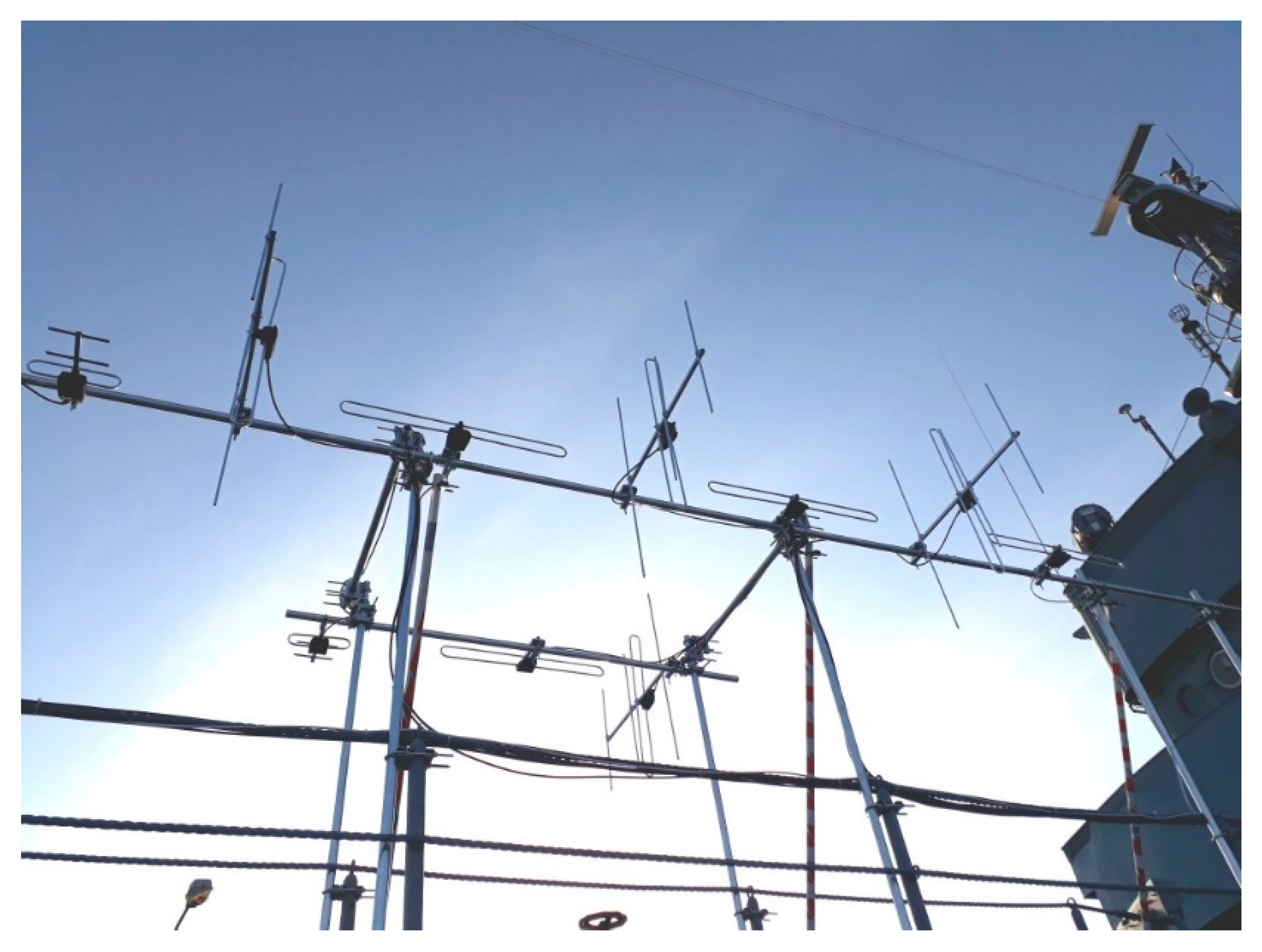
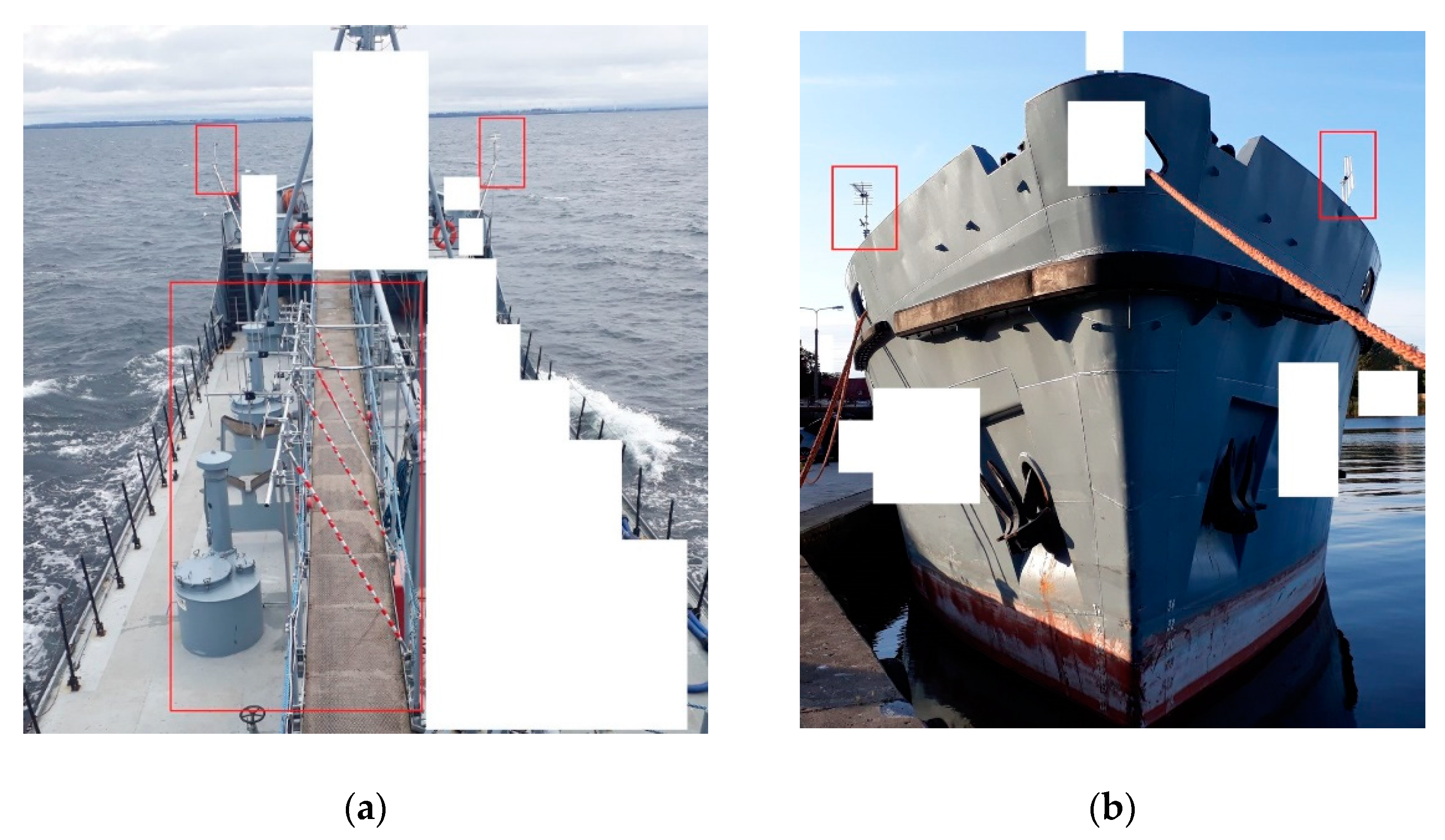
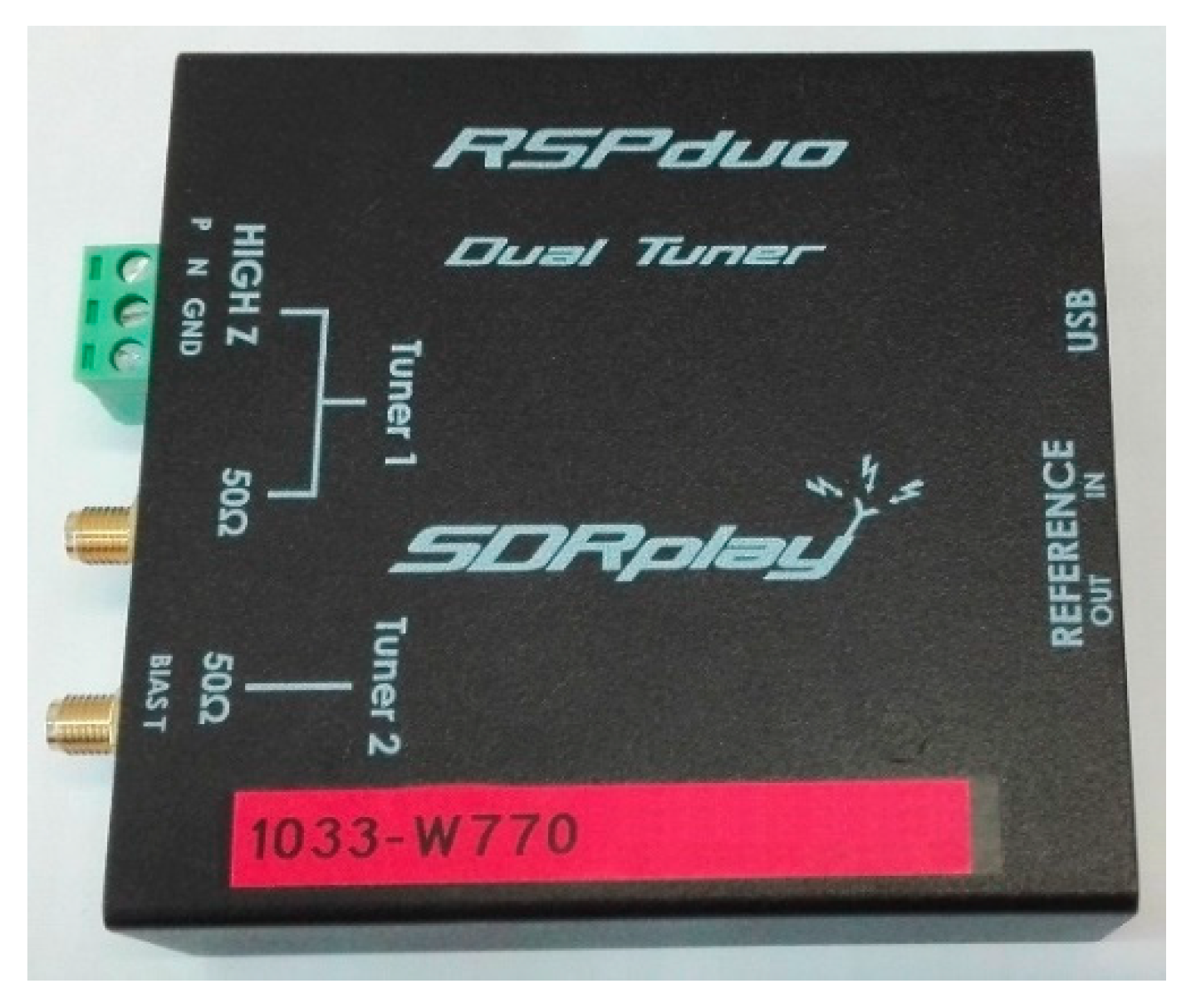
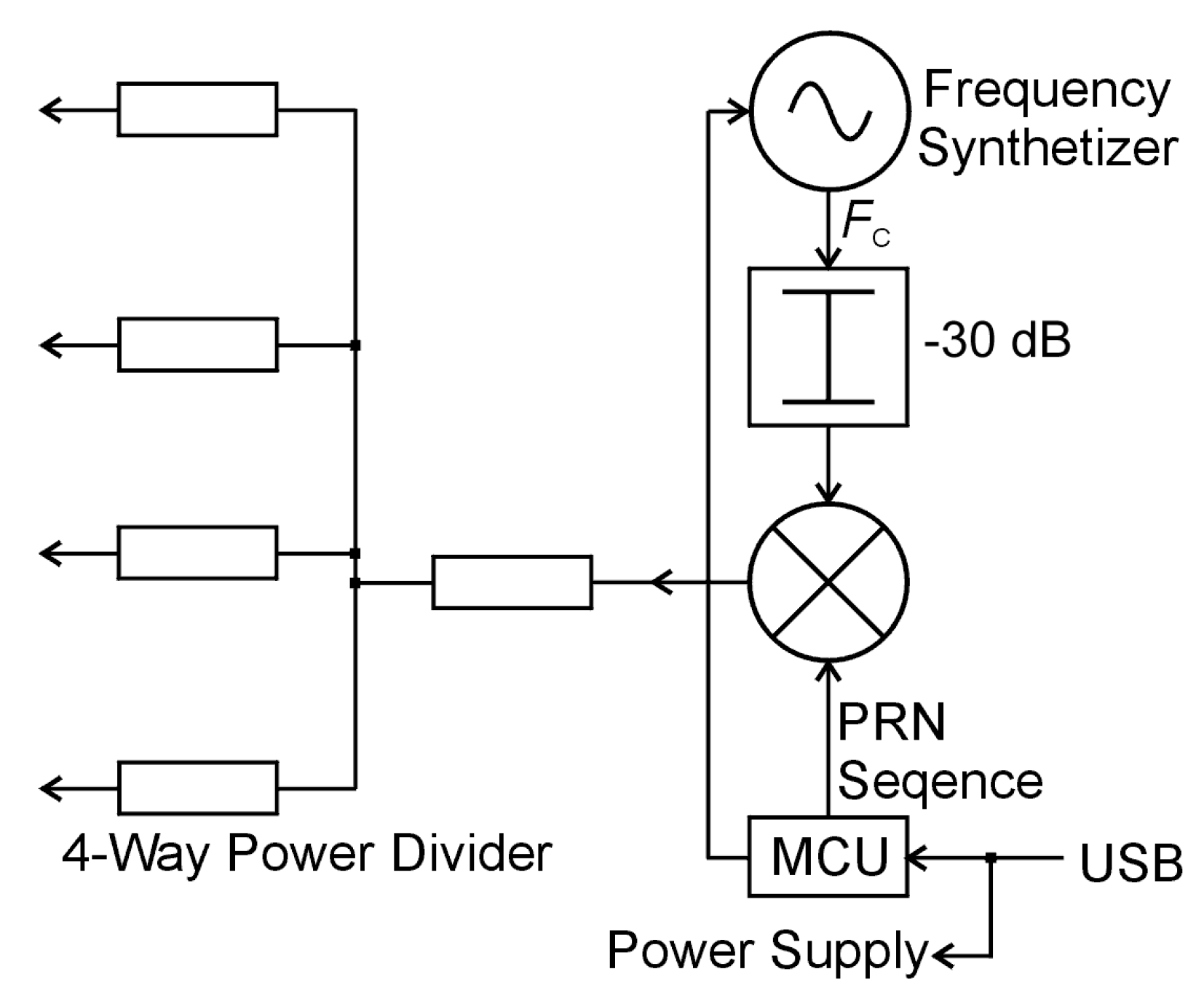
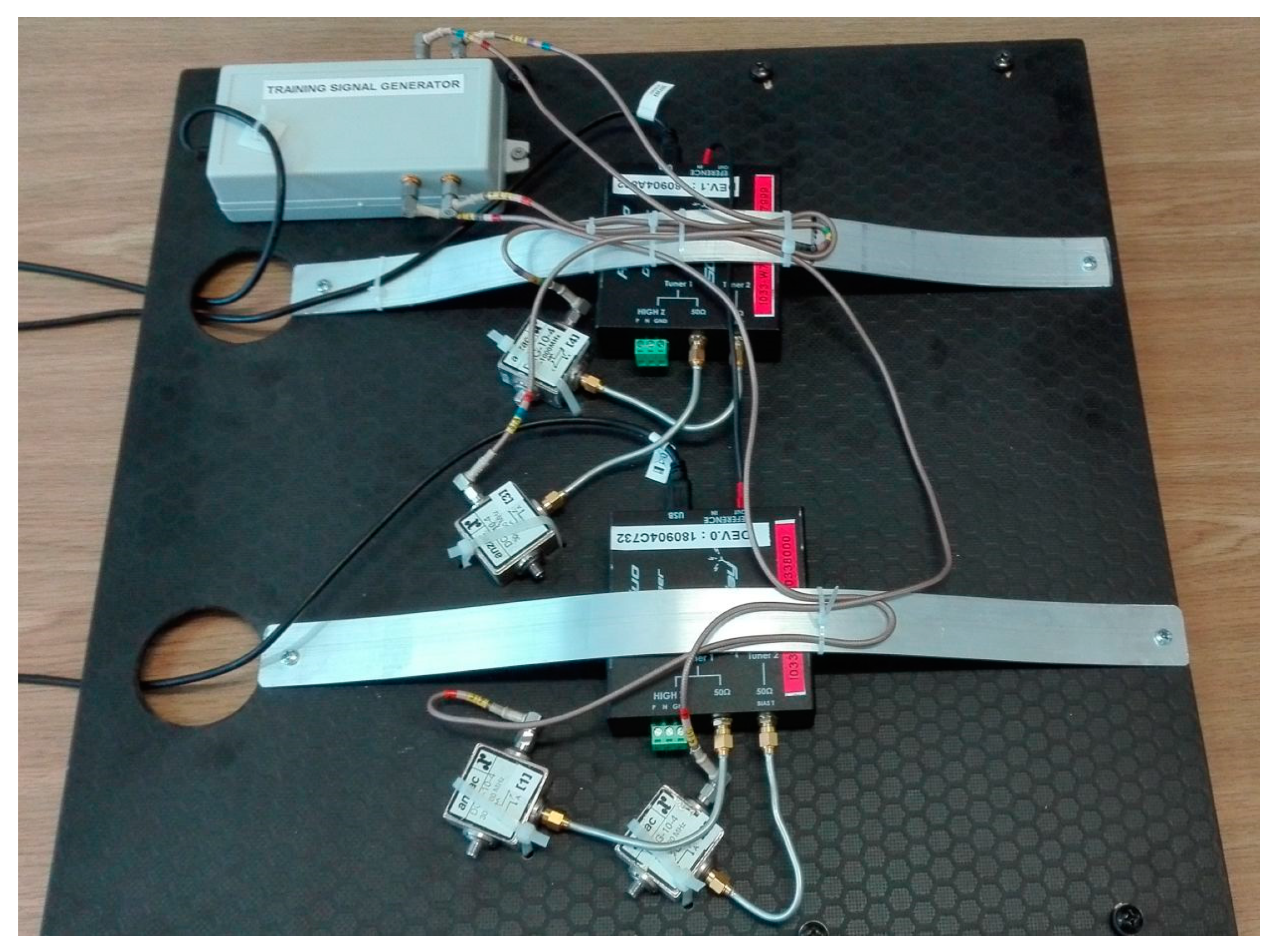

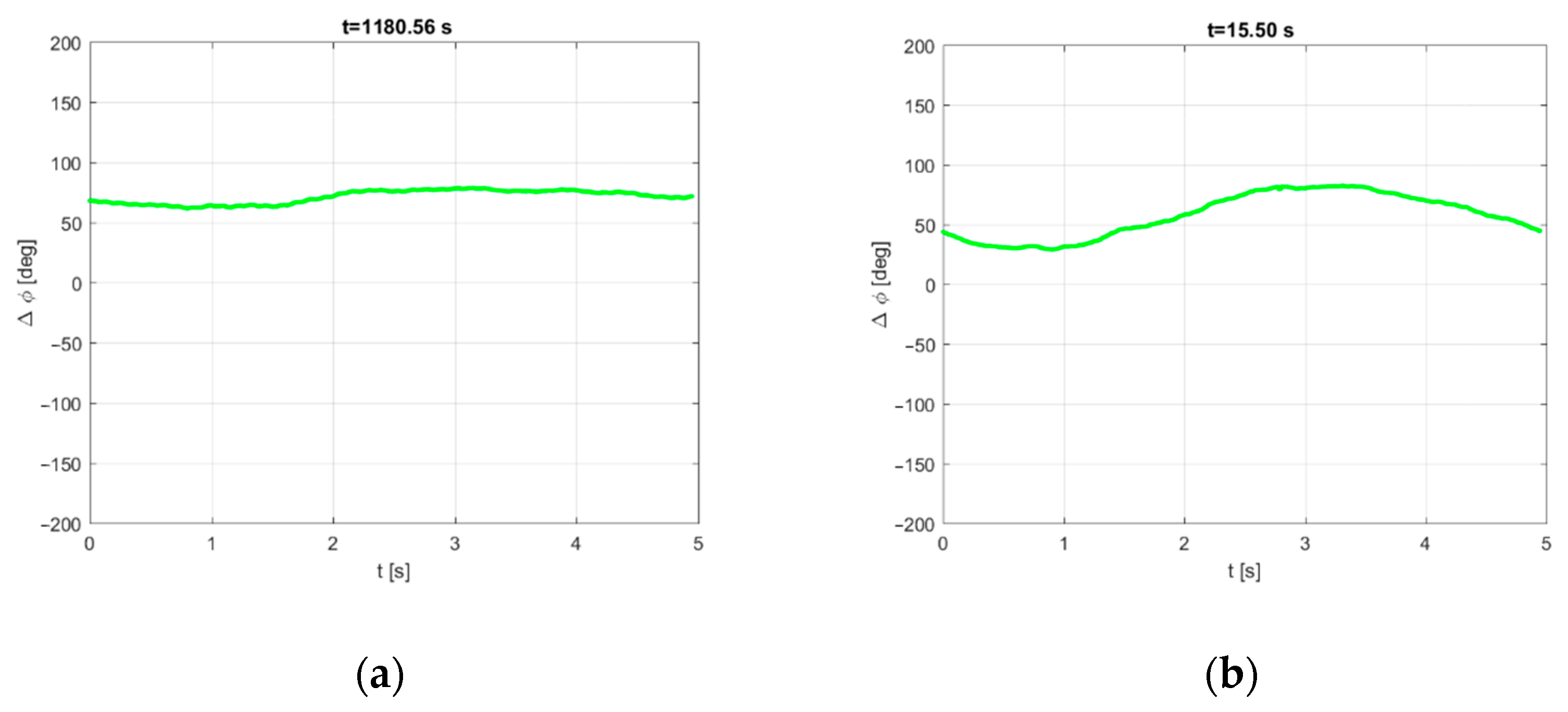



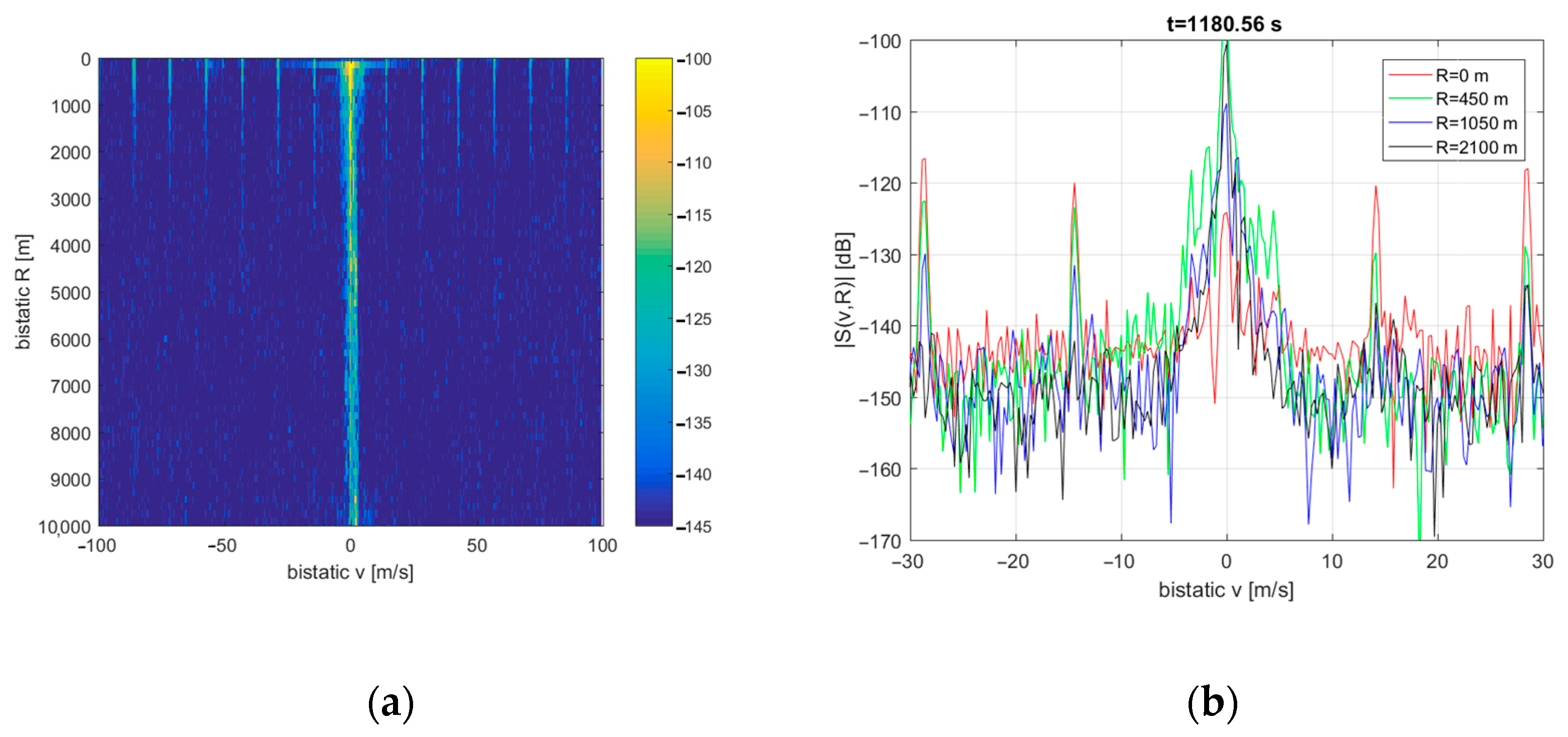
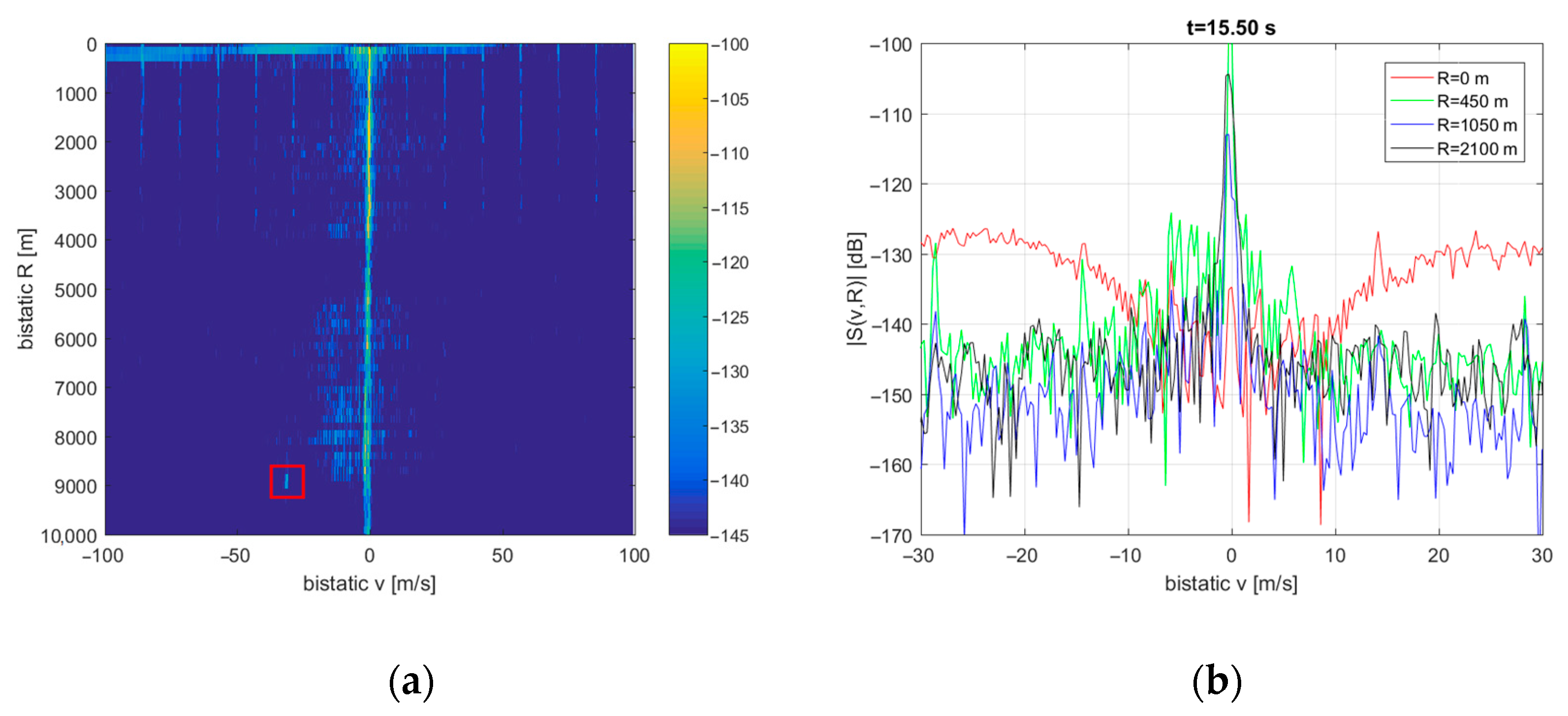
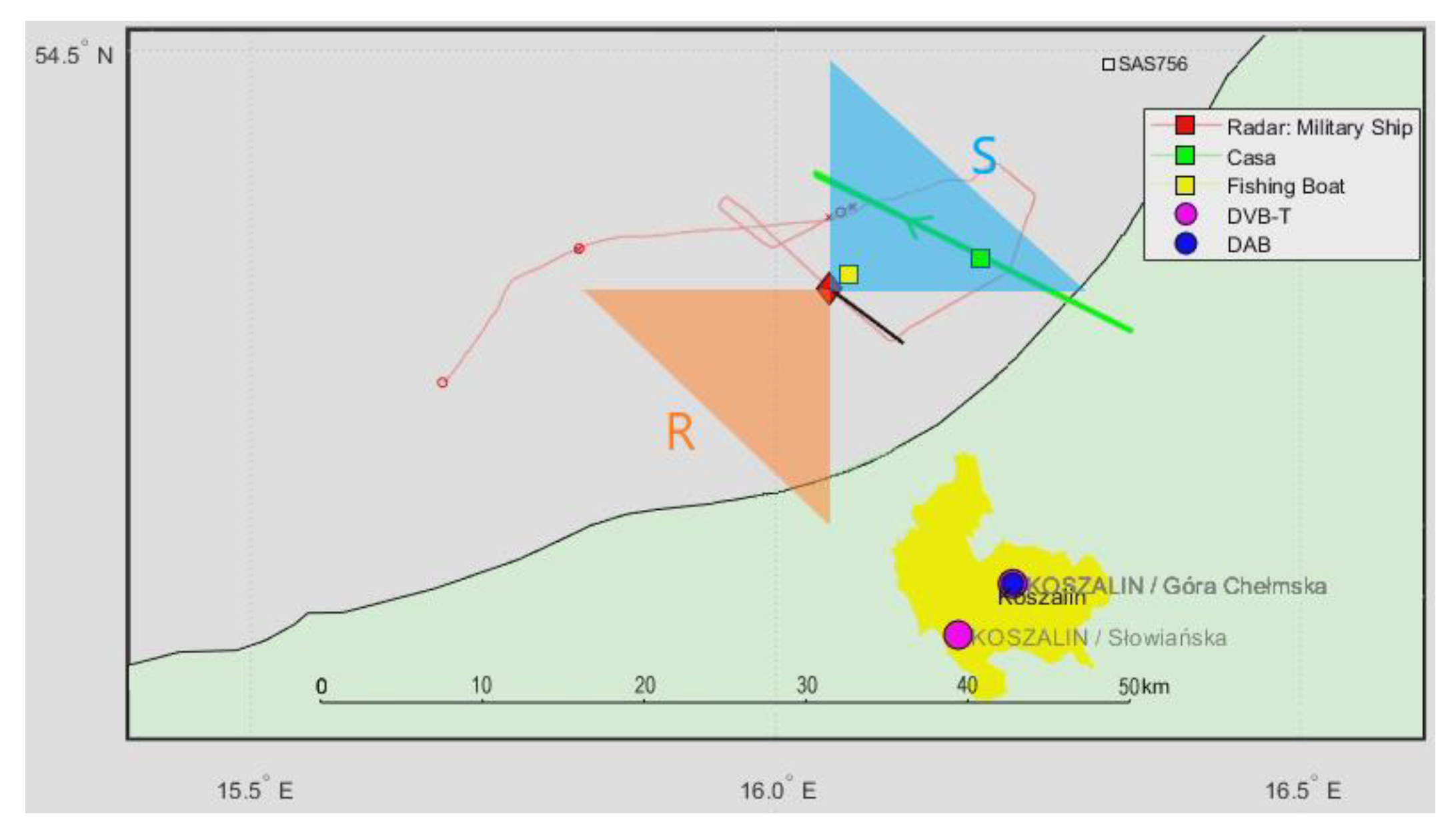
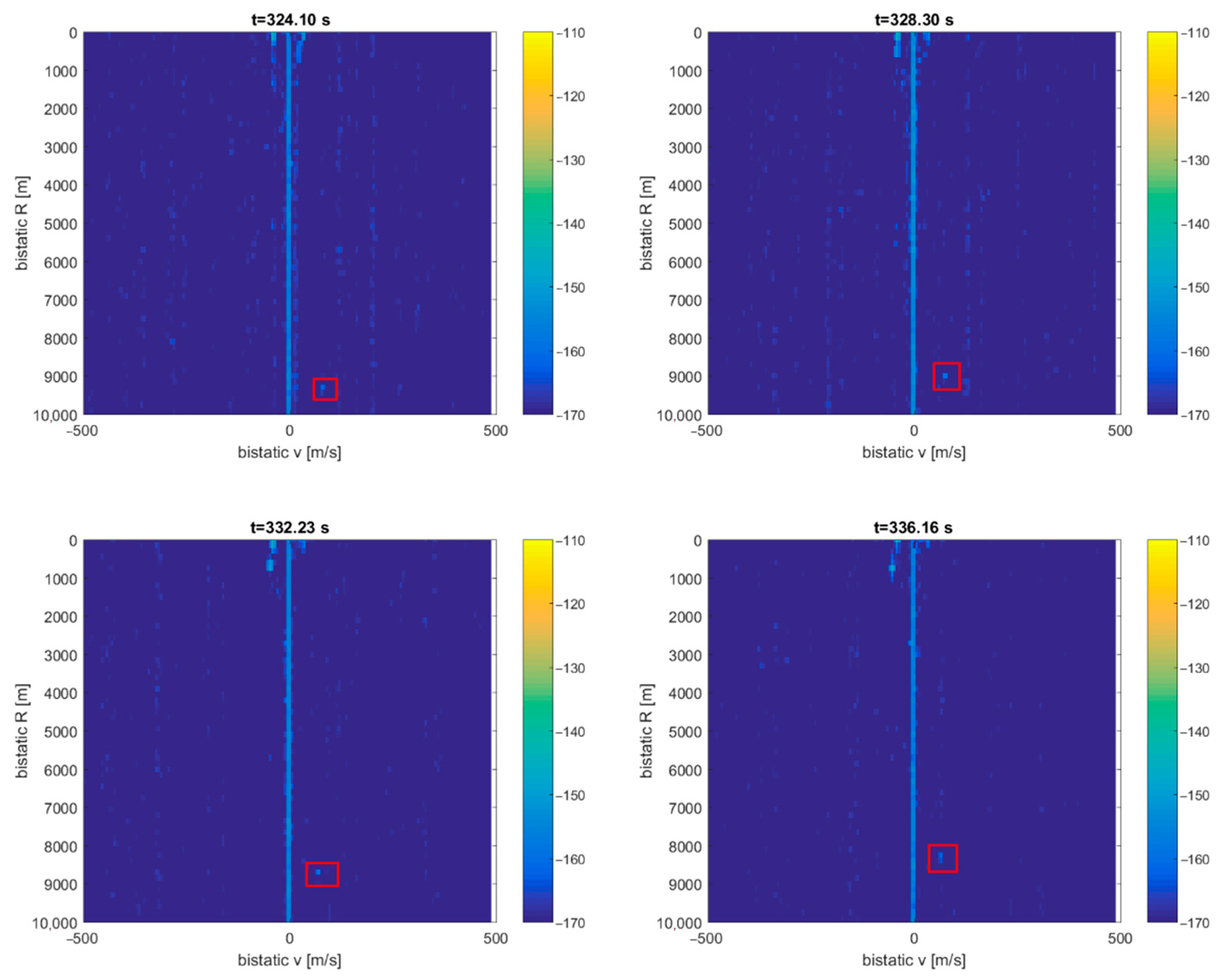

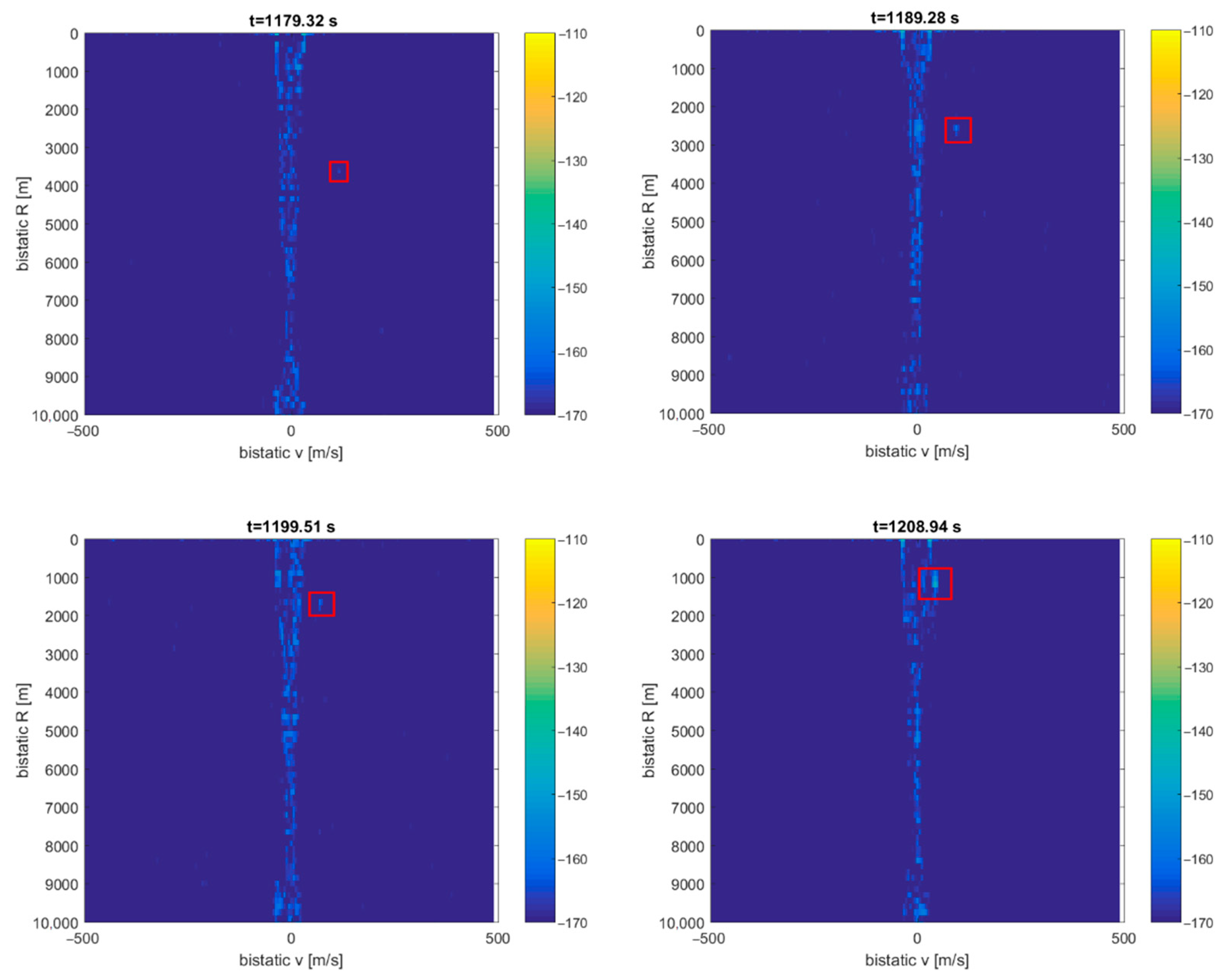
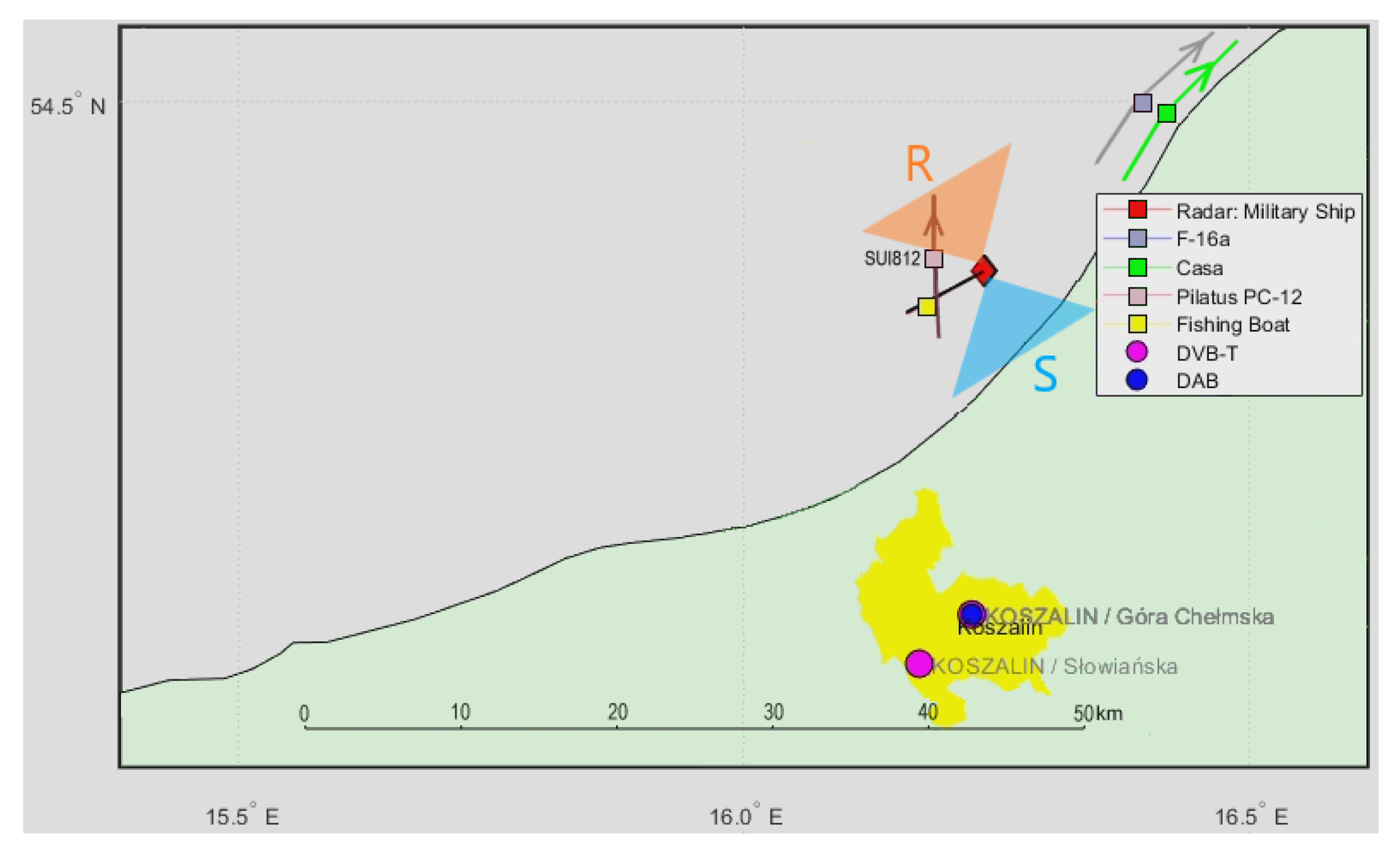
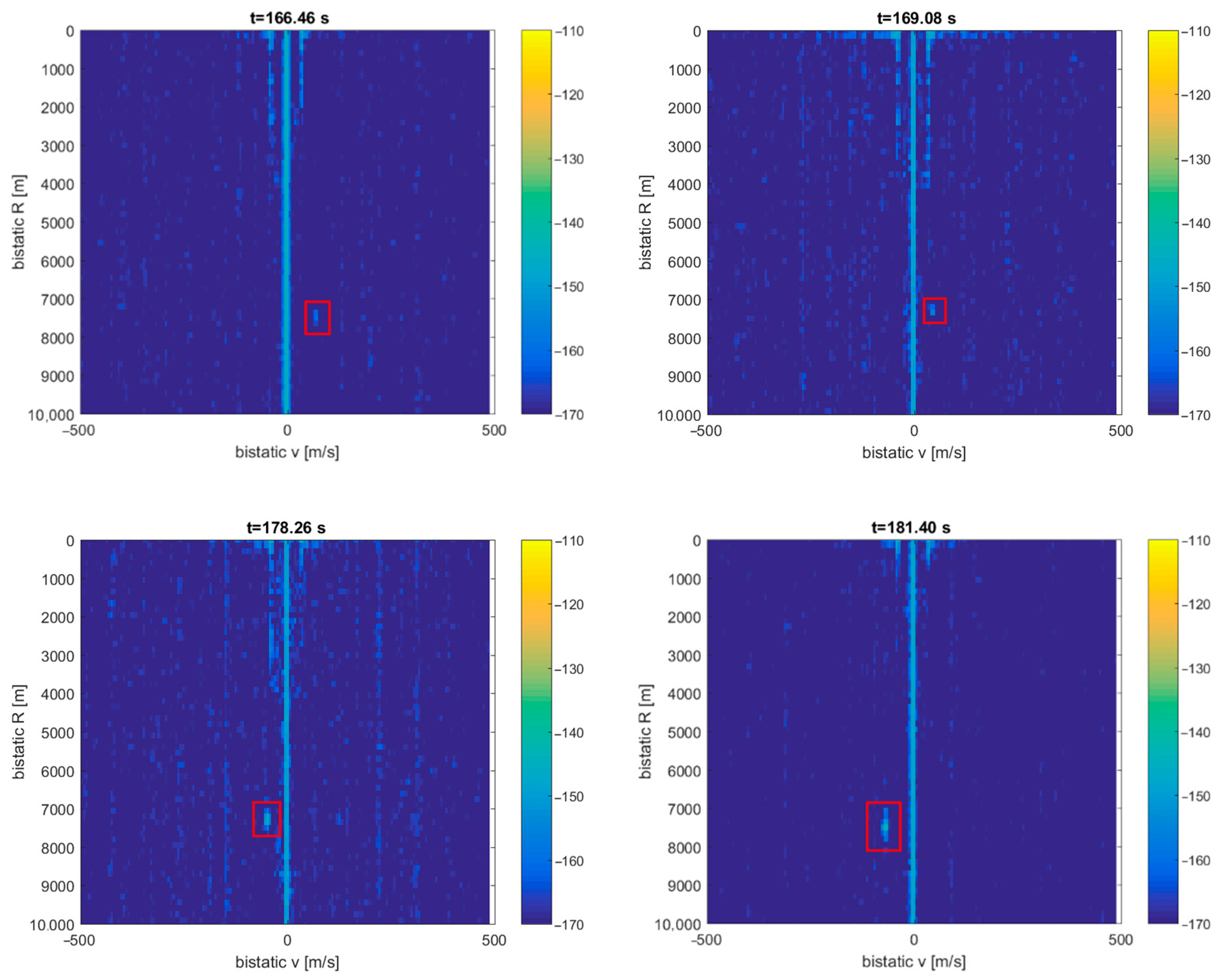
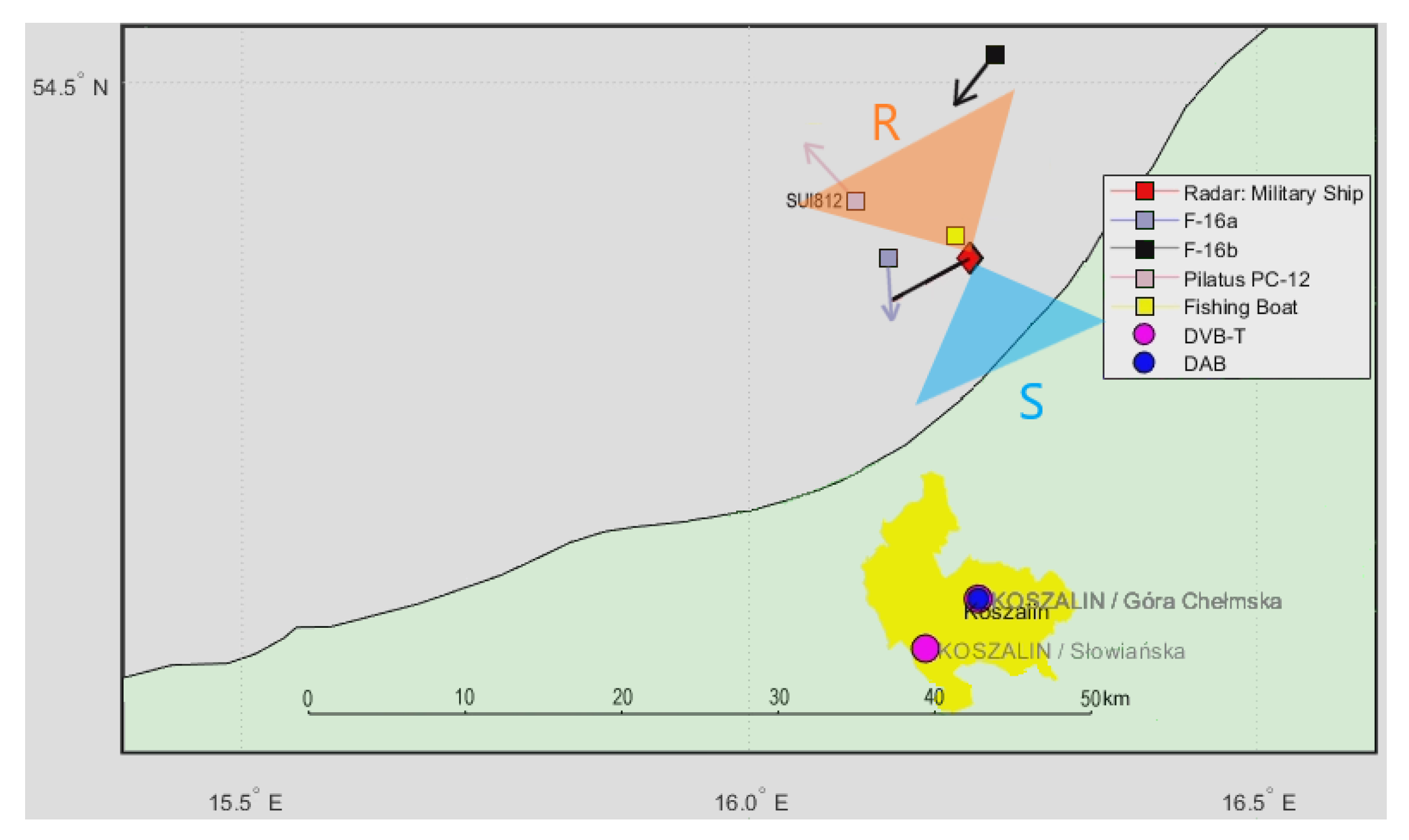
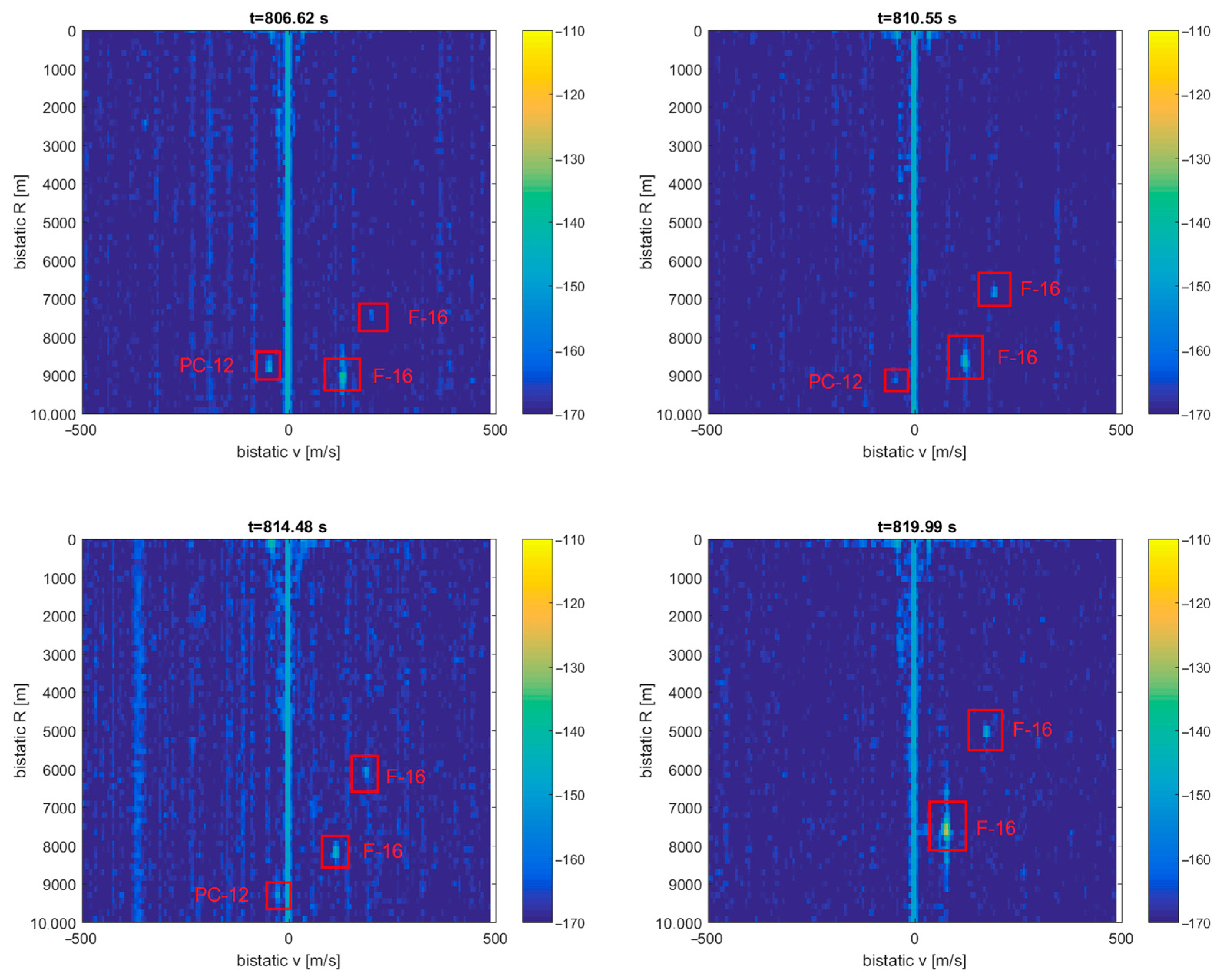
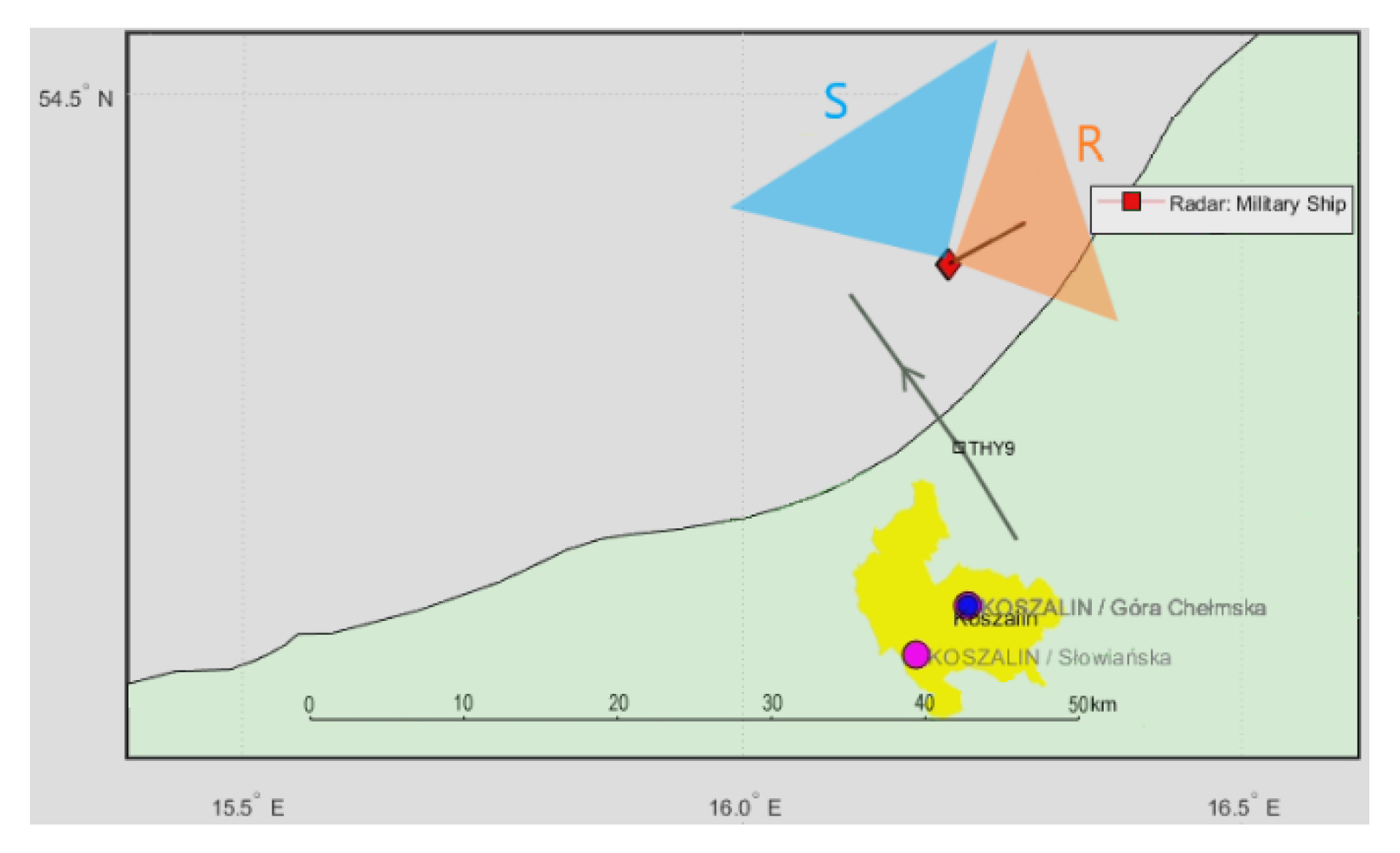

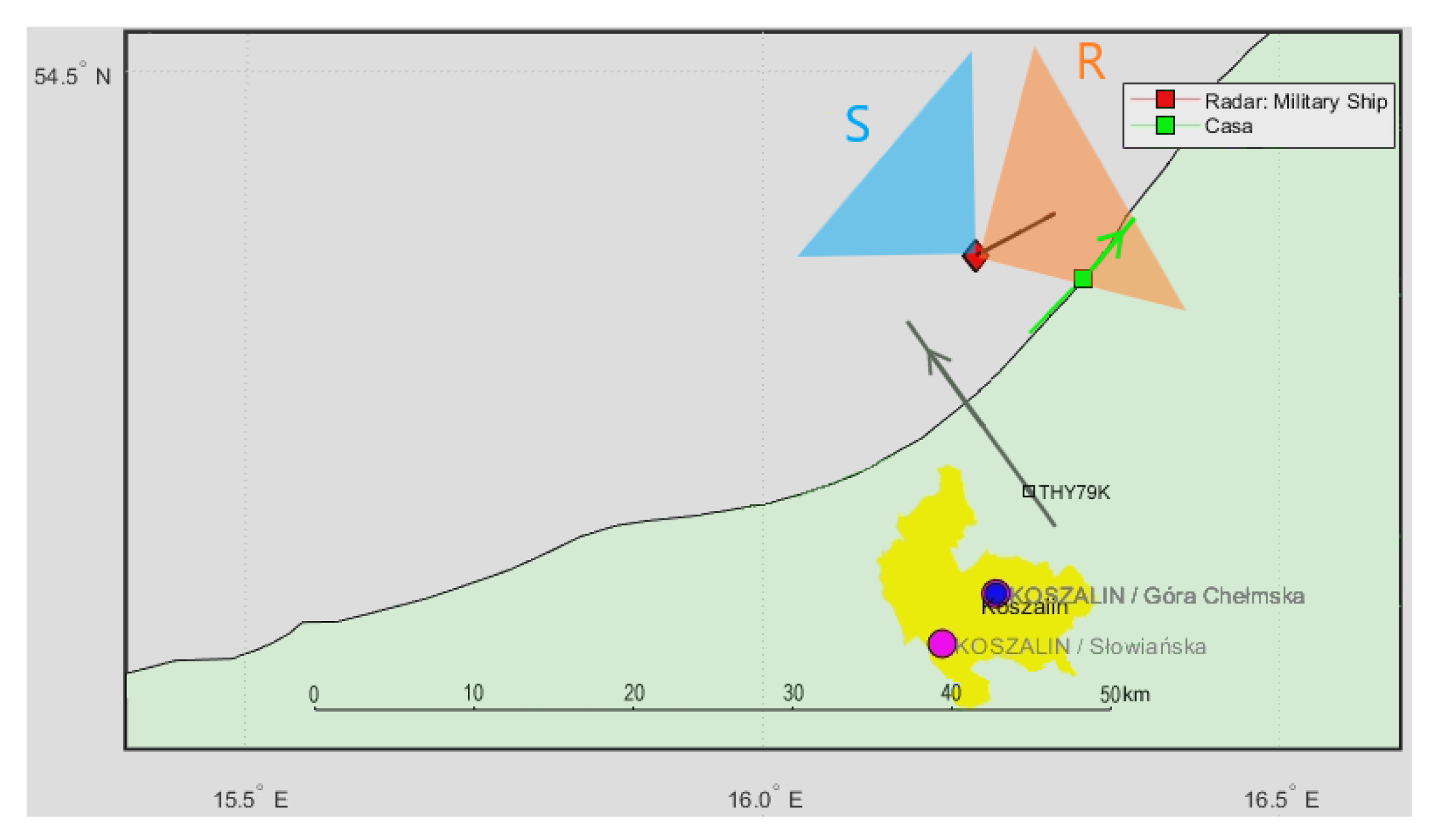
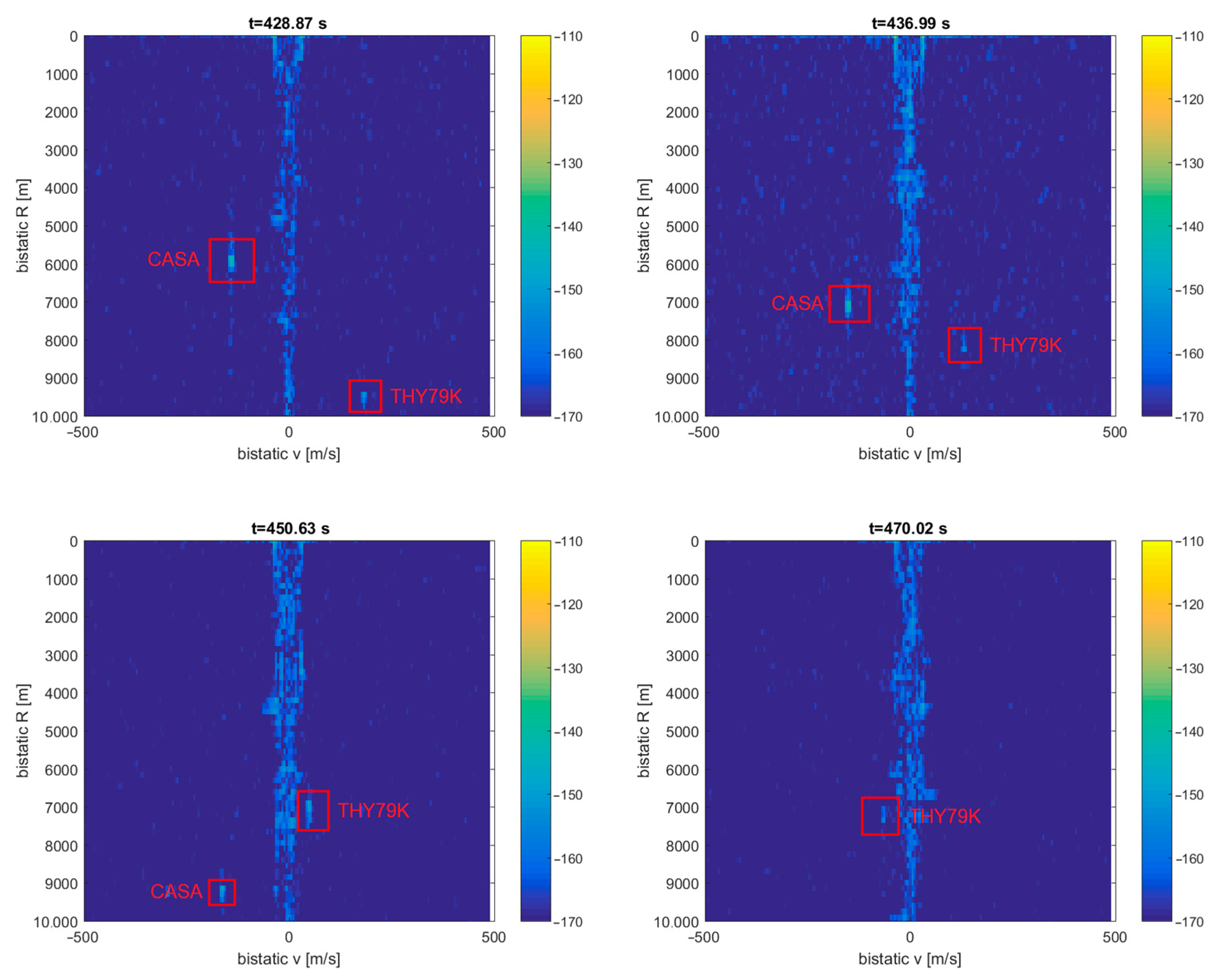
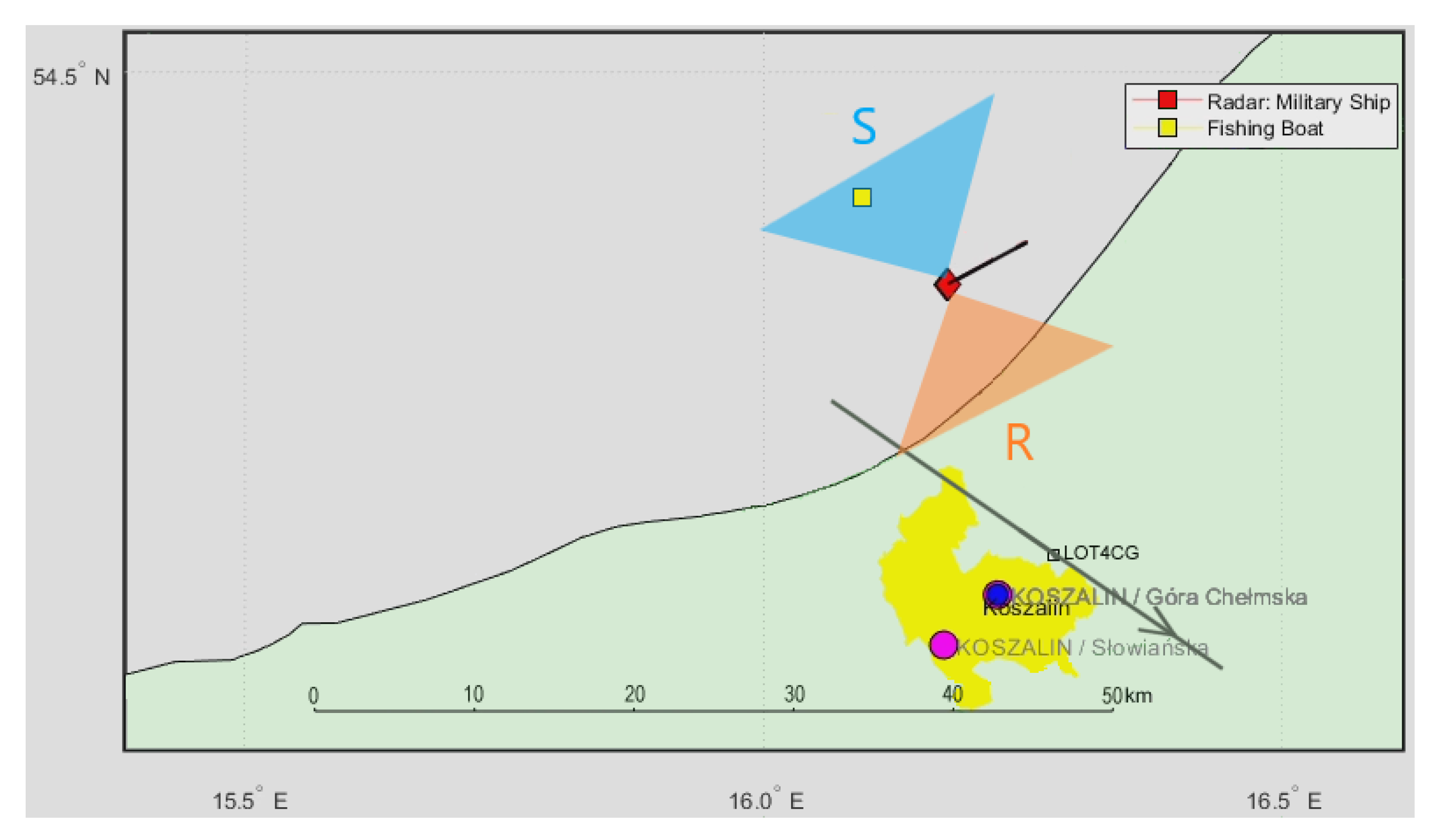
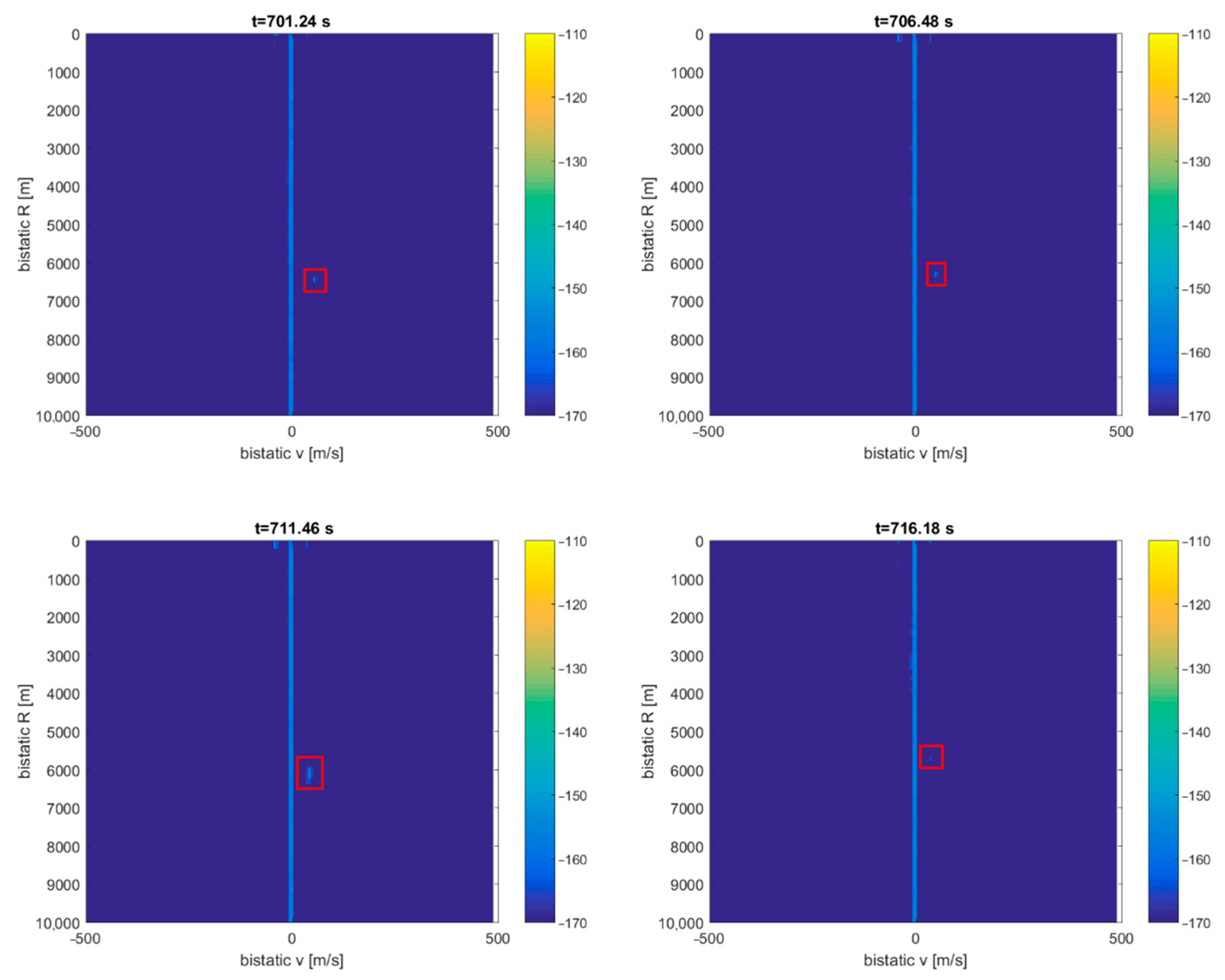
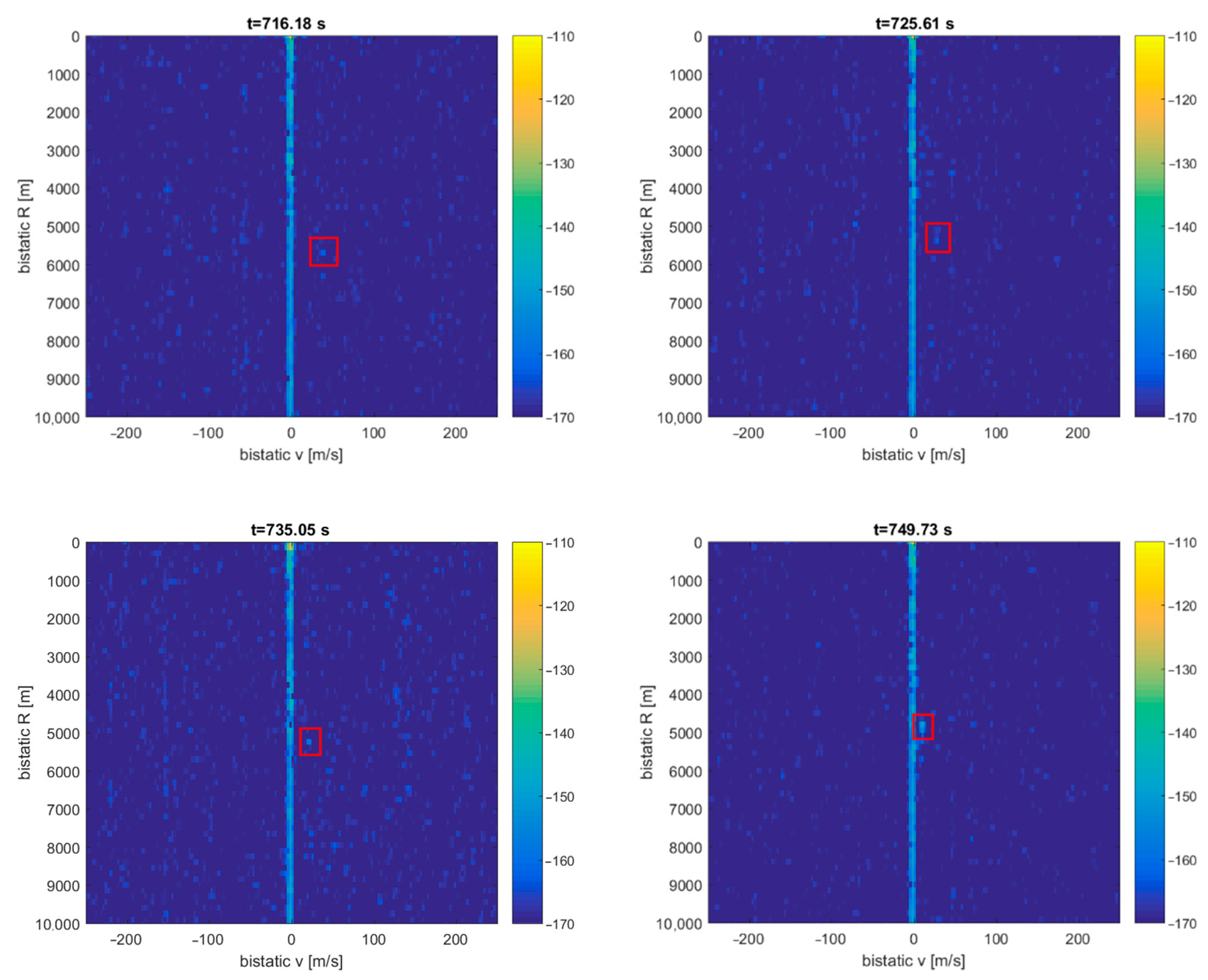
Publisher’s Note: MDPI stays neutral with regard to jurisdictional claims in published maps and institutional affiliations. |
© 2021 by the authors. Licensee MDPI, Basel, Switzerland. This article is an open access article distributed under the terms and conditions of the Creative Commons Attribution (CC BY) license (http://creativecommons.org/licenses/by/4.0/).
Share and Cite
Mazurek, G.; Kulpa, K.; Malanowski, M.; Droszcz, A. Experimental Seaborne Passive Radar. Sensors 2021, 21, 2171. https://doi.org/10.3390/s21062171
Mazurek G, Kulpa K, Malanowski M, Droszcz A. Experimental Seaborne Passive Radar. Sensors. 2021; 21(6):2171. https://doi.org/10.3390/s21062171
Chicago/Turabian StyleMazurek, Gustaw, Krzysztof Kulpa, Mateusz Malanowski, and Aleksander Droszcz. 2021. "Experimental Seaborne Passive Radar" Sensors 21, no. 6: 2171. https://doi.org/10.3390/s21062171
APA StyleMazurek, G., Kulpa, K., Malanowski, M., & Droszcz, A. (2021). Experimental Seaborne Passive Radar. Sensors, 21(6), 2171. https://doi.org/10.3390/s21062171






